Low Hydrogen Welding
Low hydrogen electrodes are recommended for three broad areas of application:
1.On low alloy, high carbon, high sulfur, or other steels where cracking is a problem.
2.When specified by governing codes.
3.For lowest costs on vertical, overhead and horizontal groove welds on heavy (over 1/2”) plate.
Procedures
Vertical Up Groove Welds . . . . . . . . . . . . . . . page 27 Overhead Groove Welds . . . . . . . . . . . . . . . . page 27 Vertical Up Fillet Welds . . . . . . . . . . . . . . . . . . page 28 Overhead Fillet Welds . . . . . . . . . . . . . . . . . . page 28 Horizontal Groove Welds . . . . . . . . . . . . . . . . pages
Recommended | Class |
Jetweld | E7018 |
E7018 | |
Excalibur® 7018 | E7018 |
Excalibur |
|
Jetweld
Employ the same techniques for this
EXX18 Welding Techniques
Procedures and techniques for E7018 electrodes can be used for E8018, E9018, or E11018 Lincoln electrodes.
Polarity - Whenever possible use electrode positive for 5/32” and smaller electrodes. AC can be used at about 10% higher currents.
Use AC on 3/16” and larger diameter electrodes to minimize arc blow for best operating characteristics. DC+ can also be used at about 10% lower currents.
